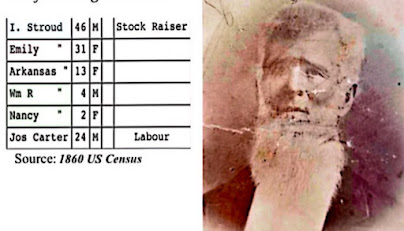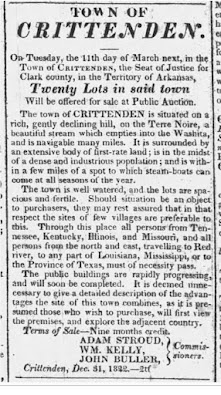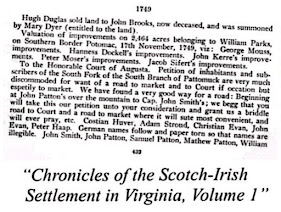Upon moving to Hampshire County after the events of the Stroud Massacre in 1772, Adam Stroud seems to have met and married Eve Hand (born 1751). It is unclear who Eves parents were, though she is said to have been born in Virginia. No record exists confirming the exact date of their marriage, but they were apparently married by the birth of their first child in 1775. This child seems to have died in infancy. In 1776 they had a second child, Catherine Stroud, and in 1778 their third child, Rebecca Stroud. Both Catherine and Rebecca lived into adulthood. In 1780 they had a daughter named Betsy, and in 1782 they had another daughter named Polly, neither of whom appear to have survived into adulthood. No records exist confirming the exact dates or circumstances of their deaths. In 1784 they had their first son; Samuel Stroud.
In 1786 Hardy County was created from the area of Hampshire County where the Stroud Family had settled. In 1782 the Stroud Family is listed as living in Hampshire County in the work "Census Index: Colonial America 1607-1789". They are later listed as living in Hardy County in the work "Virginia Tax Payers 1782-1787". In 1790 Adam and Eve had a son; Adam Stroud Jr, their first child born in the newly created Hardy County. Later, in 1792 they had yet another daughter; Susan Stroud. In 1795 they had their ninth and final child; Peter Stroud. Of the nine children born to Adam and Eve Stroud only six appear to have reached adulthood; Catherine, Rebecca, Samuel, Adam Jr, Susan, and Peter.

In 1796 a Hardy County Baptist Minister by the name of David Badgley voyaged from Virginia to the "Illinois Country". There he established the first Protestant Church in the history of Illinois in a community called New Design situated four miles south of present-day Waterloo, Monroe County, Illinois. After organizing the church at New Design, David Badgley returned to Hardy County, Virginia, to report to his friends and neighbors of the fertile country they had scouted and of the Church he had established. By the Spring of 1797 Reverend Badgley had convinced 154 people, including Adam Stroud and his family, to journey with him back to Illinois and the New Design Colony.
The journey of Reverend David Badgley and his fellow settlers from Virginia to Illinois is briefly mentioned in the work "The Pioneer History of Illinois", by John Reynolds. The most detailed account of this journey, however, can be found in the work "Foundations: a Baptist Journal of History and Theology" in a volume published in 1977 by Lyn Allison Yeager. The following narrative of the journey is derived from Yeagers account;
In the Spring of 1797, the group of 154 pioneers travelled by wagon, packhorse, and on foot, to Morgantown, Virginia, situated on the Monongahela River. From there they followed the Monongahela up to Brownsville, Pennsylvania, where they decided to have their flatboats manufactured. The Flatboat, also known as the "Kentucky Boat" or "Kentucky Flat", was the popular method of river transport at the time. They could range from 40 to 100 feet in length and usually were outfitted with a roofed shelter for protection from the elements for the passengers. The production of the groups flatboats in Brownsville took longer than expected and by May the group decided to set off in open, unfinished, Flatboats. They could wait no longer as they had to a lot themselves time to plow and plant crops by years end, and because navigation of the Ohio became more difficult after the Spring rainy season. Because the Flatboats had not been outfitted with roofed shelters the group had to endure wind, rain, and sun for the entire trip.

From Brownsville the pioneers floated the Monongahela River up to Pittsburg where it links with the Ohio River. They then floated the Ohio River for over 1,300 miles west to Fort Massac near modern day Metropolis, Illinois. Here they sold their flatboats and set out overland for the New Design Colony around 100 miles north. The overland trip took some three weeks to travel, during which time the group suffered a fever epidemic. According to the account; "Scarcely a family of all these immigrants but did not have to mourn the loss of one or more of its number." It is very possible that one or more of Adam and Eves daughters died on this voyage. They arrived at New Design in July of 1797, where David Badgley became the Pastor of the New Design Church.
(Above Image) Excerpt from “History of St. Clair County, Illinois”
(Above Image) The Journey to New Design.
Life in the New Design Colony was described as "genuinely pioneer." The Indians were a constant threat, and settlers had to build their new homes while guarding their families. They met in each other's cabins for Church services where the minister would preach dressed in "buckskin, with moccasins on his feet, shot pouch slung to his side and the ever-present rifle on his shoulder, and preached the Gospel to the few neighbors gathered inside the log cabin while others were stationed as pickets." It is here that Adam Stroud settled with his wife and four children on a tract of land in Monroe County near Fountain Creek.
Adam and Eves first daughter, Catherine Stroud, married Aaron Badgley, the son of Reverend David Badgley, on June 20*, 1799, in St. Clair County, Illinois. They settled near Belleville in St. Clair County, just north of Monroe County. Adam Stroud died in 1804, around the age of 65, in Belleville, St. Clair County, Illinois. His wife Eve died nine years later in 1813 in Monroe County, Illinois.
The following was written by Adam Badgley, son of Catherine Stroud, in the year of 1887, at age 78;
"The old folks names were Adam and Eve. They came from Virginia. They raised a family of 8: Adam, Samuel, Peter, Catherine (my mother), Rebecca, Susan, Poly and Betsy. They owned atract of land in the bottom of Monroe County North of Fountain Creek. They died there, then the children left there and went to Arkansas and never sold the land. I believe two of the heirs sold their undivided interest. The place has been sold for taxes time and again. His son Adam kept a Post Office somewhere in Arkansas for a long time. Susan and Samuel came back. She married a man by the name of Goacher. They, two, and Sam died in Jersey County, Illinois. She had no children."
(Above Image) Land Indenture naming Rebecca and Adam Strouds interest. Source; “Illinois, Monroe County, Deed Records, 1816-1900” , page 282.
The work "Portrait and Biographical Record of St. Clair County, Illinois" published in 1892 includes a sketch of the life of Adam Badgley and an excerpt from which reads;
"He was the son of Aaron and Catherine (Stroud) Badgley. Theywere natives of Hardy County, VA., the father born in the year 1773, and the mother in 1776. The mother was of Dutch parents and was the daughter of Adam and Eve Stroud - hence the pleasant little fiction in the family that their home was the Garden of Eden, with an Adam and Eve, but no serpent."
Their younger daughter, Rebecca Stroud, would marry Mordecai Zaine in 1808, also in St. Clair County. Susan and Samuel both appear to have died in Jersey County, Illinois. Their youngest son, Peter Stroud, would marry Margarett Atcheson in 1816 in St. Clair County and by 1830 he had moved his family to Arkansas joining his brother Adam Stroud Jr.




































